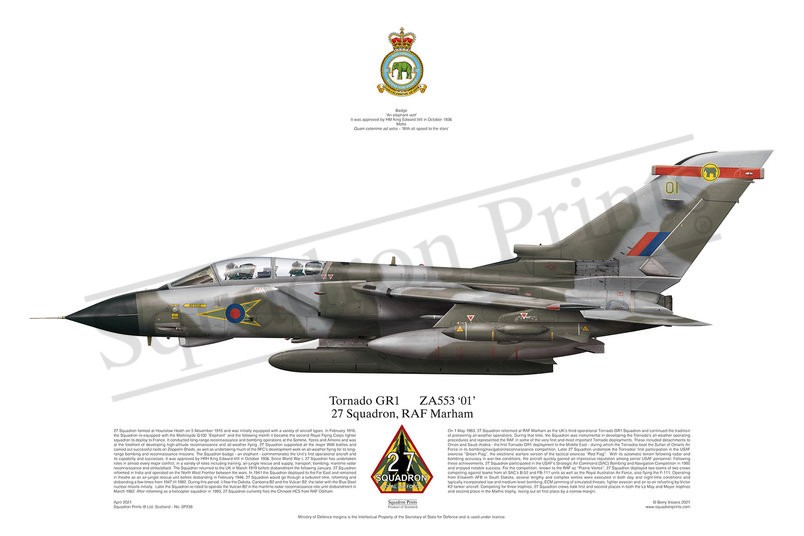#SP238 Tornado GR1 27 Squadron Print

Description
Squadron Prints Lithograph No. SP238 - Tornado GR1, ZA553 '01', 27 Squadron, RAF Marham.
27 Squadron formed at Hounslow Heath on 5 November 1915 and was initially equipped with a variety of aircraft types. In February 1916, the Squadron re-equipped with the Martinsyde G100 “Elephant” and the following month it became the second Royal Flying Corps fighter squadron to deploy to France. It conducted long-range reconnaissance and bombing operations at the Somme, Ypres and Amiens and was at the forefront of developing high-altitude reconnaissance and all-weather flying. 27 Squadron supported all the major WWI battles and carried out successful raids on Zeppelin Sheds, as well as undertaking much of the RFC’s development work on all-weather flying for its long-range bombing and reconnaissance missions. The Squadron badge - an elephant - commemorates the Unit’s first operational aircraft and its capability and successes. It was approved by HRH King Edward VIII in October 1936. Since World War I, 27 Squadron has undertaken roles in almost every major conflict, in a variety of roles including training, air-jungle rescue and supply, transport, bombing, maritime radar reconnaissance and strike/attack. The Squadron returned to the UK in March 1919 before disbandment the following January. 27 Squadron reformed in India and operated on the North West Frontier between the wars. In 1941 the Squadron deployed to the Far East and remained in theatre as an air-jungle rescue unit before disbanding in February 1946. 27 Squadron would go through a turbulent time, reforming and disbanding a few times from 1947 till 1982. During this period, it flew the Dakota, Canberra B2 and the Vulcan B2, the latter with the Blue Steel nuclear missile initially. Later the Squadron re-roled to operate the Vulcan B2 in the maritime radar reconnaissance role until disbandment in March 1982. After reforming as a helicopter squadron in 1993, 27 Squadron currently flies the Chinook HC5 from RAF Odiham.
On 1 May 1983, 27 Squadron reformed at RAF Marham as the UK’s third operational Tornado GR1 Squadron and continued the tradition of pioneering all-weather operations. During that time, the Squadron was instrumental in developing the Tornado’s all-weather operating procedures and represented the RAF in some of the very first and most important Tornado deployments. These included detachments to Oman and Saudi Arabia - the first Tornado GR1 deployment to the Middle East - during which the Tornados beat the Sultan of Oman’s Air Force in its bombing/navigation/reconnaissance competition. Later 27 Squadron undertook the Tornados’ first participation in the USAF exercise “Green Flag”, the electronic warfare version of the tactical exercise “Red Flag”. With its automatic terrain following radar and bombing accuracy in war-like conditions, the aircraft quickly gained an impressive reputation among senior USAF personnel. Following these achievements, 27 Squadron participated in the USAF’s Strategic Air Command (SAC) Bombing and Navigation Competition in 1985 and enjoyed notable success. For the competition, known to the RAF as “Prairie Vortex”, 27 Squadron deployed two teams of two crews competing against teams from all SAC’s B-52 and FB-111 units as well as the Royal Australian Air Force, also flying the F-111. Operating from Ellsworth AFB in South Dakota, several lengthy and complex sorties were executed in both day and night-time conditions and typically incorporated low and medium-level bombing, ECM jamming of simulated threats, fighter evasion and air-to-air refuelling by Victor K2 tanker aircraft. Competing for three trophies, 27 Squadron crews took first and second places in both the Le May and Meyer trophies and second place in the Mathis trophy, losing out on first place by a narrow margin.
You may also like
-
A-10A, F-15C, F-15E, F-16C, F-22A
00-4012; 79-0171; 83-0037; 88-0423; 96-0200422 TES, 53 WingNellis AFB, Nevada -
SALE RIAT 2015 Print F-5, F-16, Typhoon, Spitfire, P-1
P7350 'EB-G'; 505; ZK349 'GN-A'; 5507; AE.9-010 '23-04'RIAT 2015RAF Fairford
